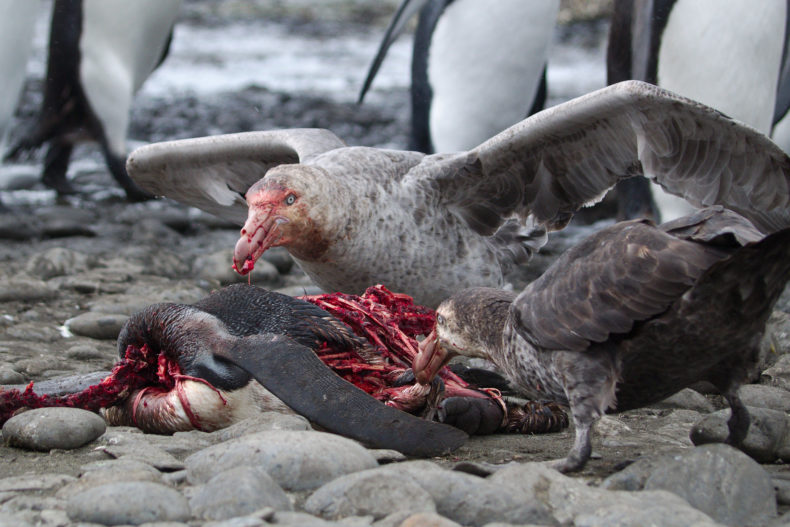There was one thing I was certain of: My toes were not polychaetes. They were not mollusks. They were not fish, nor were they squid. They were me.
But there was one thing the giant petrel was equally certain of: My toes were meat.
The seabird was approximately the size of a schnauzer with the head of a pterodactyl and cold, pale, undead eyes. Grounded from flight by a recent molt, it chased me at a surprisingly quick waddle around a chain-link cage on webbed feet bigger than my palms. My host, a jovial Chilean biologist, had neglected to tell me that closed-toe shoes were advisable when visiting the giant petrel at the wildlife rehabilitation center.
“It must be around feeding time,” the biologist said with an indulgent chuckle. I hopped ineffectively around the enclosure, squeaking as the bird used its evil-looking pterodactyl bill to spear the appendages that my sandals left so unwisely exposed. Thus bloodied, I faked right, then left, then sprinted for the door. Had I not, I surely wouldn’t be alive to tell this tale.
You know what happened to the Ancient Mariner, right? He shot an albatross with a crossbow while it was flying over his ship and the wind vanished, marooning the unlucky sailors in the open ocean. Everyone on board except the Ancient Mariner slowly cooked to death and then skeletonized in the sun.
If there is a lesson here, it is not that you should not shoot albatrosses lest you incur the wrath of nature***. It’s that, given the chance, seabirds will kill you.
Search “giant petrel” on the Internet, for example, and you will learn from Reddit that “It’s hard to find an image of a giant petrel that ISN’T covered in blood.” Or that doesn’t have its head submerged inside of a bloated marine mammal. Or that isn’t sparring for a mate with head covered in gore and putrid grease. Or that isn’t displaying dominance atop a corpse in something called the “sealmaster posture.” Their wing shape evokes “the curved steel blade of a big paper cutter,” notes Eric Wagner in his book Penguins in the Desert. Sailors of the southern oceans feared the giant petrel, Wagner writes, because it had a reputation for attacking those who fell overboard, slicing up their arms and targeting “the face and eyes with the glorious hook on the end of their ‘fossil carved ivory’ bills” as they drowned. In Spanish, they have been called “Quebrante Huesos.” It translates literally as “Breaking bones.”
Lest you think that giant petrels are all there is to fear among the oceanic avian, think again. Kelp gulls attack the backs of southern right whale calves, eating pieces of them while they’re alive and leaving hideous scars. Penguins make terrible noises. Murres poop on each other.
And even if seabirds don’t kill you, they almost certainly will throw up on you. All of the birds in the order to which the giant petrel belongs, the Procelleriiformes, have a tendency to vomit a foul-smelling orange liquid when alarmed. Last summer, a crab researcher on the Alaskan island where I was volunteering as a seabird counter reported running into a parade of fulmars. Each bird startled at his vessel’s sudden appearance from the fog, each ralphed, and then each gracefully, menacingly, veered away as the next oncoming bird startled, ralphed, and so on. The one time I helped handle cormorant chicks for another research project, we wore head-to-toe olive green slickers to deflect the showers of vomit and then used a high pressure hose to spray off the fish chunks, crab chunks, and splattered poo. A chick savagely attacked my face while I was carrying it, leaving chunks of its post-vomit gray mucus in my mouth, all the while making cartoonish Donald Duck sounds. It’s a miracle I survived.
And storm petrels, the smallest of the Procelleriiformes, are nocturnal when they travel over land. And we all know that no one does things at night unless they are up to something Suspicious. Something indescribably Horrible and Deadly.
So the next time you see a penguin or a gull or some other innocuous-looking sea-faring bird, do yourself a favor: Run. Or for God’s sake, at least wear closed-toe shoes.
Banner image courtesy of Flickr User Rob Oo
***Actually, that is the lesson. Albatrosses are incredible birds, as shown in this captivating and darkly beautiful film from Chris Jordan, and they are succumbing to everything from plastic pollution to invasive predators. If you shoot them, nature will kill you.
Can’t get enough Snark? Why not graze on the terrifying tales of Snark Weeks past:
Snark Week 2017, featuring abusive blackbirds, an immense, near-spherical raccoon, and the vile creature that will gnaw on your soul – and then poop on it.
Snark Week 2016, featuring testicle-eating assassins, chihuahua terrorists, raptors who dole out violent haircuts, and the animals so vile they come out of the womb with horns.
Snark Week 2015, featuring flesh-ripping alien fleas, bovine murderers, and the unfairly beloved animal whose terrifying extra neck vertebrae allows them to turn their terrifying neckheads 270 degrees.
Snark Week 2014, featuring squirrels hell bent on world domination, more feral roosters, and a furry virus that has spread across the United States to total devastation.
Snark Week 2013 – the very first! – featuring the ant that kills cows, the bird responsible for five deaths and $425 million in damages, and an animal so vicious he is known only as Little Red Bastard.

There’s something magical about seeing seabirds when you have been 100s of km out to sea for several weeks. Not sure what it is. Maybe it’s the reminder that there is land somewhere out there.